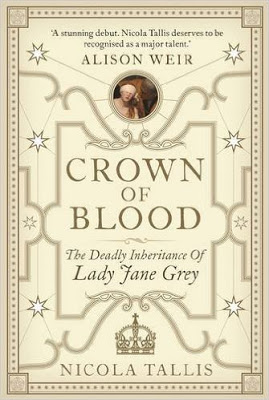It’s publication day for Nicola Tallis’s wonderful debut book, Crown of Blood: The Deadly Inheritance of Lady Jane Grey! To mark the occasion, I have a fascinating myth busting guest post to share with you. Please join me in congratulating Nicola on the release of her new book.
The Mythology of Lady Jane Grey
By Nicola Tallis
On the morning of 12 February 1554, the seventeen-year-old Lady Jane Grey was executed within the confines of the Tower of London. From almost the moment of her death, misconceptions and myths began to coil themselves around her name. Many of these myths have endured over the centuries, while ever more elaborate embellishments and elements have emerged in order to increase their poignancy. As a result, the truth has become obscured, and the real Jane increasingly mysterious. Even today, some of the myths surrounding Jane’s life are still accepted without question. Jane is often remembered as a tragic victim, a view that has persisted through the passage of time. Though this image is indeed partially true, it is also grossly unfair: there was far more to Lady Jane Grey than that.
So where do we start? At the beginning, with Jane’s birth seems to be the most logical place, but even here there are problems. We do not know precisely when or where Jane was born, and this has provided perfect fodder for mythmakers. The tower at Jane’s childhood home in Bradgate Park, known as ‘Lady Jane’s Tower’, was once believed to have been the place of Jane’s birth, but evidence has shown that even if Jane had been born at Bradgate (which I would dispute), the tower in question would not have been where such an event took place. Any further conclusions about Jane’s birth must be based on an array of detective work and logic given the lack of conclusive documentary evidence.
For centuries it was also believed that Jane was the product of an abusive home, where she was subjected to regular beatings and was desperately unhappy. This view was dramatized in Trevor Nunn’s 1986 film, Lady Jane, where Jane is forced to endure a violent attack at the hands of her mother, Frances, Duchess of Suffolk. The film did little to help Frances’s reputation as a cruel, tyrannical mother, and served to further enhance the portrayal of Jane as a victim. Neither did the double portrait that now hangs in the National Portrait Gallery help matters. Now correctly identified as Lady Dacre and her son, Gregory Fiennes, the portrait was once believed to depict a rather plump Frances, and her much younger second husband, Adrian Stokes. This in itself is incorrect, for Adrian Stokes was in fact a little under two years younger than Frances. The view of Jane as a victim of cruel parental abuse has, however, been challenged by several modern historians, including myself (see my book for more!). Nevertheless, there are still those that believe that the traditional view is correct.
One of the most common myths surrounding Jane – her tagline, if you like – is that she was queen for just nine days. Indeed, the label of the Nine Day Queen has stuck hard, but it, too, is inaccurate. Jane was queen for thirteen days: admittedly, in the grand scheme of events an additional four days may seem insignificant, but for Jane and her supporters these four days counted for a great deal. These were the days that elapsed between the death of Edward VI on 6 July 1553, and Jane’s public proclamation as queen on 10 July. The fact that only nine of her thirteen days as queen were conducted in the public eye, as it were, has earned Jane her misnomer. Yet in these four days, Jane was given time to come to terms with her heightened status whilst plans were laid for her smooth succession: plans that were doomed to failure.
Following Jane’s deposition and her condemnation for treason on 13 November, initially it seemed likely that Mary I would exercise her prerogative to show mercy and spare Jane’s life. However, following the failure of the Wyatt Rebellion in February 1554 and the foolish involvement of Jane’s father, Henry Grey, Duke of Suffolk, Mary was left with little choice but to order Jane’s execution. It has been commonly said, however, that Mary offered to spare Jane’s life if she would convert to Catholicism. It is certainly true that Mary sent her own chaplain, Dr John Feckenham, to Jane in an attempt to persuade her to convert, but the purpose of her doing so was not with the aim of saving her life if Jane agreed, but her soul. Mary did however agree to postpone Jane’s execution by three days in order to allow Feckenham time to fulfil the task, but it was to prove pointless. Jane defiantly informed the chaplain that her belief in her faith was so resolute that she was prepared to die for it, and thus she began to prepare for her end.
There is one more pervasive myth to add to the tale: the story goes that following Jane’s execution, her body was secretly removed from the Tower of London to her childhood home, Bradgate Park for burial. This was a story that was circulated in the Victorian era, and is almost certainly untrue. Though her skeleton has never been discovered, there is little plausible reason to believe that Jane was not interred within the Tower of London’s own chapel, the Chapel of St Peter ad Vincula, where she almost certainly rests to this day.
Since her death many myths have attached themselves to Jane, and some may persist into the future. While some undoubtedly contain an element of truth, no matter how small, others are complete and utter fabrication. What is certain, however, is that now is the time to look beyond the myths, and instead concentrate on what we do know to be true of Jane: that she was a girl of character, intellect, and strength. As such, Lady Jane Grey deserves to be remembered as more than one of history’s victims.
Buy Crown of Blood
Amazon US (Released in the US on 5 December, 2016)
About the Author
Nicola Tallis has a first class BA (Hons) in History from Bath Spa University. She also has an MA in Public History from Royal Holloway College, University of London, and is studying for her PhD at the University of Winchester. Nicola has been passionate about English history all of her life, and has worked as a curator, lecturer, and historical researcher. Crown of Blood is the result of five years of research on the Grey family, and is her first book.
Find out more about Nicola at her website: http://nicolatallis.com

















You state, “The view of Jane as a victim of cruel parental abuse has, however, been challenged by several modern historians, including myself (see my book for more!).” Has your view of Frances changed, then? In this post, Allison Weir cites you as sharing her traditional view of Frances as an abusive parent.
http://nancybilyeau.blogspot.com/2015/07/an-interview-with-alison-weir.html
Just curious to know before I buy your book.
Hi Susan,
Thank you for your question – yes it has. I did once concur with the traditional view, but have since reevaluated. I hope that helps!